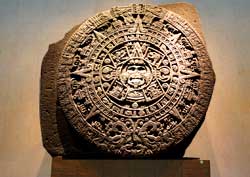National Museum of Anthropology
 Why the
National Museum
of Anthropology
is special
Why the
National Museum
of Anthropology
is specialIt is one of the world's finest museums. Many of the pre-Hispanic archaeological treasures of Mexico are artfully on display.
National Museum of Anthropology tips and insights
Museum has two sections
Each section covers a distinct time period of Mexico's culture and history.
-
Ground floor
Focuses on pre-Hispanic objects. - Second floor
Concentrates on contemporary ethnic life.
Top 3 exhibition halls
The National Museum of Anthropology has about two dozen exhibition rooms, too many to explore in one day. It's best to be selective.
To get you started, here are the three most interesting halls along with their star items:
-
Mexica Hall (Aztec)
Study upclose the famous 3.5-meter (12-foot) high Sun Stone. See photo above.
- Teotihuacan Hall
Teotihuacan Hall
View a colorful replica of a sculpted wall of the Quetzalcoatl Temple.
- Maya Hall
See the Tomb and burial artifacts of Pacal, the great ruler of Palenque.
The famous Sun Stone (see photo above) is popularly known as the Aztec Calendar. That's a misnomer because the huge stone portrays the four prior universes of the Aztec theology.
Other must-sees
They include the colossal Olmec heads carved from huge basalt rocks. And, there is the replica of Montezuma's stunning headdress (the original has been in Austria for centuries, but a serious effort is underway to have it returned to Mexico).
Conversation piece
The National Museum of Anthropology has a modern architectural conversation piece that seems to defy the laws of balance. A firm, large, heavy rectangular canopy hovers over part of the outdoor patio. It is supported only by a single column, around which falls a high curtain of water.
Guided tour
Most of the exhibits have Spanish, but no English signage. I recommend that on your first visit you take a guided tour.
How to avoid the crowd
Sunday is the most crowded day. If you can only go then, visit in the early or late part of the day.


